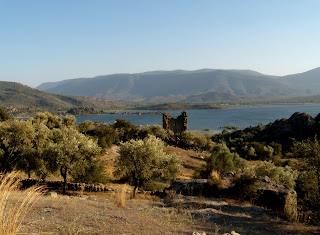Herakleia-by-Latmos is one of those odd places to
visit. The remains of the ancient city are squeezed between the Latmos Mountains
and the edge of Lake
Bafa. However, you have
to find them!
Today’s village of Kapıkırı
holds few promises of interesting ruins as its houses are built on top of
the ancient remains. It takes a careful eye to spot abandoned walls,
towers, column drums rooted into a tree, and other heart-shaped drums among the
modern constructions.
To start with, the place is off the beaten path
and hard to find. That was not always the case because, in antiquity, Herakleia had full
access to the sea deep inside a vast gulf. Over the centuries, this gulf has
mainly been silted up with the alluvia carried along by the Meander River. By the end
of the 3rd century AD, access from the sea was cut off, and all that remained
was Lake Bafa.
When Alexander the Great besieged Miletus, he
and his army arriving from Priene
had to march along the shores of this vast Latmian Gulf.
Now, looking south from Priene
towards Miletus, we’ll
notice a flat plain that was once at the bottom of the sea.
It is generally admitted that Herakleia was
founded by Pleistarchus,
son of Antipater (see:
Antipater and Alexander), in the early 3rd century BC. He ruled over
large parts of Caria and made Herakleia his capital,
initially named after him, Pleistarcheia.
Pleistarcheia/Herakleia prospered in Hellenistic times as
goods arriving by sea from the west were forwarded further by road into
the Carian hinterland. An extensive network of roads, probably conceived by Pleistarchus exiting the
city, has been discovered. It is not easy to piece the remaining sections
together because, over the centuries, its stones have been reused elsewhere. As the pavement shows no ruts from carts and is occasionally
interrupted by stairs, these roads were only used by pedestrians, horses, and
beasts of burden. They connected, however, with essential thoroughfares in the
valley of the Meander.
Archaeologists eventually bring the scattered
remains to life by recognizing the constructions from antiquity. The open space
of the Agora is easiest to spot by the modern visitor as it functions as a
parking lot. The marketplace measured an impressive 60x110m and was surrounded
by marble colonnades in the Doric style. This was the center for commerce and trade
of cattle, agricultural products, and honey in particular.

Overlooking the Agora are the walls of a temple
built in the Doric order with two, now missing, columns at the entrance. It was
most probably dedicated to Athena. Inscriptions on the outside walls of the
temple reveal that it served as an archive to the city. They also give us
essential information about the history of Herakleia and Asia Minor in the early 2nd century BC. In those days,
the ambition of the Seleucid king Antioch III was to rule over all of Asia Minor. However,
the Romans defeated him at the Battle
of Magnesia ad Sipylum
in 190 BC. The blocks with these inscriptions are scattered on the temple's north side. From the south side, another inscription was recovered that is
being kept at the Louvre. This is a letter by Lucius Cornelius Scipio, Consul of Rome, and Publius Scipio, his brother,
addressed to the Boulé and the people of Herakleia.
Also dating from the 2nd century BC are the
Bouleuterion, the theater, and the Gymnasium. There are, of course, many other
remains from temples and houses that need further investigation. From later
dates are the Roman Baths, a Nymphaeum, as well as remains of the city walls.
The ramparts are among the best-preserved of their time, extending for more
than 6 km
and counting over 40 towers. In places, they stand to a height of 6 meters.
Herakleia’s necropolis is located in the far
south of the city, as always outside the walls. A large, not yet excavated
tumulus is believed to belong to Pleistarchus.
Hundreds, maybe even thousands, of rock-cut graves do not immediately catch the
eye as they appear as mere rectangular openings in the rock wall.
The
conclusion is that there is far more to explore and discover than one
would expect at first sight! As mentioned in my bibliography, I’ll gladly refer to the beautiful book, although
written in German Herakleia
in Latmos by A. Peschlow-Bindokat.




No comments:
Post a Comment